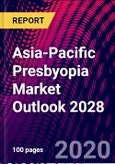Asia-Pacific Presbyopia Treatment Market Analysis 2019-2028
Presbyopia is the progressive deterioration of the eyes to concentrate on surrounding objects. It typically becomes visible in the early to mid-40s and begins to deteriorate until around 65 years of age. The Asia-Pacific presbyopia treatment market accounted for a market value of around USD 1700 million in 2019 and is anticipated to reach around USD 3600 million by 2028, by growing at a CAGR of 8.51% during the forecast period i.e. 2020-2028. Since presbyopia is a lens-based condition, majority of the future solutions are based on the development of intraocular lenses. The future technologies include adjustable intraocular lenses, multifocal intraocular lenses, and others.
Owing to the rising number of people suffering from presbyopia and the growing geriatric population, the Asia-Pacific presbyopia treatment market is anticipated to expand rapidly over the forecast period. Key players in the presbyopia market in Asia-Pacific are focusing on developments and improvements in presbyopia treatment. The companies provide approved products in the market to increase credibility and brand value in the market. In addition, various manufacturers across the region are adopting massive developments such as user-friendly designs, software upgrades for improved visualization and treatment procedures. Rapidly growing internet penetration across Asia-Pacific countries is making it possible for enterprises to reach out where members are not present at all.
The Asia-Pacific presbyopia treatment market consists of various segments that are segmented by age group and treatment type. The market is further segmented by age group less than 40, 40-60-year-old, above 60. Out of these, the 40-60-year-old segment accounted for the largest market share of around 60% in the Asia-Pacific presbyopia treatment market in 2019. Difficulty in reading small print, having to hold reading material farther away, headaches, and eyestrain are some of the symptoms of presbyopia.
On the basis of treatment type, the market is segmented into corrective eyeglasses, contact lenses, refractive surgery, lens implants, and pharmacological treatment. Among them, the corrective eyeglasses segment accounted for the largest market share in 2019. Bifocal eyeglasses or progressive lens eyeglasses are most commonly prescribed by doctors. Typically, a bifocal lens is broken into two parts. To fix distant vision, the larger portion is used, while the smaller lens helps the patient to see up and near. In addition, eyeglasses are considered the easiest and most secure method of treating presbyopia.
Some of the affluent leaders in the Asia-Pacific presbyopia treatment market are NIDEK CO., LTD, Johnson & Johnson Vision Care, Inc., Alcon Vision LLC, Carl Zeiss AG, Bausch & Lomb Incorporated, Essilor International, Ziemer Ophthalmic Systems AG, Topcon Corporation, Novartis AG and others.
Presbyopia is the progressive deterioration of the eyes to concentrate on surrounding objects. It typically becomes visible in the early to mid-40s and begins to deteriorate until around 65 years of age. The Asia-Pacific presbyopia treatment market accounted for a market value of around USD 1700 million in 2019 and is anticipated to reach around USD 3600 million by 2028, by growing at a CAGR of 8.51% during the forecast period i.e. 2020-2028. Since presbyopia is a lens-based condition, majority of the future solutions are based on the development of intraocular lenses. The future technologies include adjustable intraocular lenses, multifocal intraocular lenses, and others.
Owing to the rising number of people suffering from presbyopia and the growing geriatric population, the Asia-Pacific presbyopia treatment market is anticipated to expand rapidly over the forecast period. Key players in the presbyopia market in Asia-Pacific are focusing on developments and improvements in presbyopia treatment. The companies provide approved products in the market to increase credibility and brand value in the market. In addition, various manufacturers across the region are adopting massive developments such as user-friendly designs, software upgrades for improved visualization and treatment procedures. Rapidly growing internet penetration across Asia-Pacific countries is making it possible for enterprises to reach out where members are not present at all.
The Asia-Pacific presbyopia treatment market consists of various segments that are segmented by age group and treatment type. The market is further segmented by age group less than 40, 40-60-year-old, above 60. Out of these, the 40-60-year-old segment accounted for the largest market share of around 60% in the Asia-Pacific presbyopia treatment market in 2019. Difficulty in reading small print, having to hold reading material farther away, headaches, and eyestrain are some of the symptoms of presbyopia.
On the basis of treatment type, the market is segmented into corrective eyeglasses, contact lenses, refractive surgery, lens implants, and pharmacological treatment. Among them, the corrective eyeglasses segment accounted for the largest market share in 2019. Bifocal eyeglasses or progressive lens eyeglasses are most commonly prescribed by doctors. Typically, a bifocal lens is broken into two parts. To fix distant vision, the larger portion is used, while the smaller lens helps the patient to see up and near. In addition, eyeglasses are considered the easiest and most secure method of treating presbyopia.
Some of the affluent leaders in the Asia-Pacific presbyopia treatment market are NIDEK CO., LTD, Johnson & Johnson Vision Care, Inc., Alcon Vision LLC, Carl Zeiss AG, Bausch & Lomb Incorporated, Essilor International, Ziemer Ophthalmic Systems AG, Topcon Corporation, Novartis AG and others.
Table of Contents
Asia-Pacific Presbyopia Treatment Market3. Executive Summary - Asia-Pacific Presbyopia Treatment Market4. Regulatory Landscape6. End-User Analysis7. Product Usability Analysis8. Average Pricing Analysis9. Impact of COVID-19 on the Presbyopia Treatment Market10. Risk Analysis11. Investment Opportunity Analysis12. Regional Analysis of Presbyopia Treatment Ecosystem13. Product Portfolio Comparative Analysis
1. Introduction
2. Research Methodology
5. Analysis of Market Dynamics
14. Asia-Pacific Presbyopia Treatment Market Outlook
15. Competitive Landscape
Companies Mentioned
- NIDEK CO. Ltd
- Johnson & Johnson Vision Care Inc.
- Alcon Vision LLC
- Carl Zeiss AG
- Bausch & Lomb Incorporated
- Essilor International
- Ziemer Ophthalmic Systems AG
- Topcon Corporation
- Novartis AG








